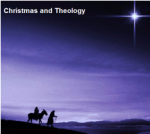Kenneth L. Gentry Jr.'s Blog, page 102
January 14, 2016
MISGUIDED REJECTIONS OF POSTMILLENNIALISM (4)
 PMT 1016-004 by Greg L. Bahnsen (edited by Kenneth L. Gentry, Jr.)
PMT 1016-004 by Greg L. Bahnsen (edited by Kenneth L. Gentry, Jr.)
(Gentry note: This is the fourth in a four-part series on “Misguided Grounds for Rejecting Postmillennialism.” This article was originally written by Dr. Greg L. Bahnsen, but is presented here as edited by Kenneth L. Gentry, Jr. In this article, Dr. Bahnsen considers “Premature Charges.”)
In addition to the misguided and failed attempts to dismiss postmillennialism based on (1) newspaper exegesis, (2) misrepresentation, and (3) the application of two-edged criticism (which applies to the critic as well as the position criticized), there are current day charges against the position which are premature or unfounded.
To this category belongs the allegation that postmillennialism is founded on Old Testament passages rather than New Testament evidence,[1] that the New Testament knows nothing of the proclamation of a semi-golden age.[2] Such statements do not bear their own weight in the face of postmillennial appeals to New Testament passages like the kingdom growth parables of Matthew 13, the apostle John’s teachings about the overcoming of Satan and the world (e.g., John 12:31-32; 16:33; I John 2:13-14; 3:8; 4:4, 14; 5:4-5), Peter’s Pentecost address (Acts 2:32-36, 41), Paul’s declaration that all Israel shall be saved (Rom. 11:25-32), his resurrection victory chapter in I Corinthians 15 (esp. vss. 20-26, 57-58), the statements of Hebrews 1-2 about the subjection of all enemies to Christ in the post-ascension era (1:8-9, 13; 2:5-9), and numerous passages from Revelation, notably about the vastness of the redeemed (7:9-10), the open door for missionary triumph and the Christian’s reign with Christ over the nations (2:25-27; 3:7-9), the submission of the kingdoms of this world to the kingdom of Christ (11:15), and the utter victory of gospel proclamation (19:11-21). Opponents of postmillennialism may wish to dispute its interpretation of such passages, but it is groundless for them to allege without qualifications and without detailed interaction with postmillennial writings that the position is not taken from the New Testament itself.
Thine Is the Kingdom
(ed. by Ken Gentry)
Contributors lay the scriptural foundation for a biblically-based, hope-filled postmillennial eschatology, while showing what it means to be postmillennial in the real world.
See more study materials at: www.KennethGentry.com
Further premature criticisms would include Walvoord’s accusation that postmillennialism obscures the doctrine of Christ’s second coming by including it in God’s providential works in history,[3] and Adams’ charge that it confounds the millennium with the eternal state – since it takes Old Testament prophecies of kingdom peace and prosperity and illegitimately applies them to the New Testament mention of the millennium, and thereby winds up with the dilemma that either there is no need for a new heavens and earth (to which the Old Testament prophecies really apply) or else the millennium is frustrated.[4]
Walvoord has failed to grasp adequately the postmillennialist’s philosophy of history; it is not the case that the postmillennialist fails to distinguish providence from consummation, but rather that he sees providence as well orchestrated to subserve the ultimate ends of consummation. And in connection with this understanding, he recognizes that the New Testament speaks of Christ “coming” in various ways (contrary to Walvoord’s apparent thought that there is only one single sense in which Christ “comes,” namely, at his return in glory) – for example, in the first-century establishment of his kingdom (Matt. 16:28), in the person of the Holy spirit at Pentecost (John 14:18, 28; cf. vs. 16; Acts 2:33; I Cor 15:45; II Cor. 3:17), in fellowship with the repentant and obedient believer (Rev. 3:20; John 14;21-23), in historical judgment upon nations (Matt. 24:29-30, 34; Mark 14:61-62), and upon churches (Rev. 2:5, 16). Such “comings” of the Lord are part of God’s providential government of pre-consummation history and are in addition to Christ’s visible and glorious coming in final judgment (II Thess. 1:7-10). The postmillennialist does not obscure the second coming with providence.
Nor does he, as Adams said, confound the millennium with the eternal state; the postmillennialist clearly knows the difference between the two. It is just that he disagrees with Adams that certain Old Testament prophecies pertain exclusively to the eternal state. Prior to the amillennialists and postmillennialists engaging in full exegetical debate over such passages, it would be just as legitimate for the postmillennialist to accuse Adams of confounding the eternal state with the millennium. The postmillennialist has a sound rationale for connecting relevant Old Testament passages with the New Testament millennium, in that these passages (according to postmillennialist claims) speak of the pre-consummation prosperity of Christ’s kingdom, and the millennium is precisely the pre-consummation form of his kingdom. Such Old Testament passages are taken to be (at least in part) predictions concerning a pre-consummation state of affairs because they speak of things which are inappropriate to the eternal state (e.g., opposition to the kingdom, evangelism, kingdom growth, national interaction, death, etc.). Again, the opponents of postmillennialism may dispute its interpretation of such passages, but it is premature to accuse the position of confounding two openly recognized distinct entities (namely, the millennium and eternity) prior to refuting the exegetical reasoning of the position. Postmillennialism is not suspect in advance, any more than amillennialism is.
Wall of Misconception: Separation of Church and State
(by Peter Lillback)
Examines our nation’s historic understanding of and the founding fathers intention in the relationship of our Constitution to matters of faith, ethics, and morals, taking into account the historical and biblical context as well as the concept s relation to today’s culture.
See more study materials at: www.KennethGentry.com
A further groundless criticism of postmillennialism as a system is Adams’ claim that it has even less reason to expect a semi-golden age in history than does the premillennialist, since there is nothing but sinful, non-glorified humanity to produce it, and that it has no explanation for the anticipated sudden change of conditions in the world at the end of history.[5] Such statements are unwarranted, for the postmillennialist sees the powerful presence of Christ through the Holy spirit as sufficient reason to expect the release of Satan from the post-resurrection restraints on his deceiving power over the nations as adequate explanation of the change of world conditions at the very end of the age (just as Adams does). Such tenets have been made well known in postmillennial teaching, and thus Adams’ criticism is an obvious oversight of what is an important element of the position criticized.
A similar reply is called for with respect to Walvoord’s criticism that postmillennialism deprives today’s believer of the hope of Christ’s imminent return.[6] The fact is that postmillennial never claimed to salvage the doctrine of the any-moment return of Christ; indeed, distinctive to it is the denial of the imminent physical return. The New Testament definitely indicates that the coming of the Lord is a delayed event, and that the Christian should expect to see precursor signs of its approach.[7] It is not to come upon him as an unexpected thief (I Thess. 5:4), for he believes the Scriptures that certain things must first occur (cf. II Thess. 2:1-3, etc.). Indeed, it was the error of the foolish virgins to expect the imminent coming of the bridegroom (Matt. 25:1-8). Hence postmillennialism can hardly be faulted for not preserving a doctrine which it does not, by the very nature of its position, think should be preserved (cf. Matt. 25:5, 10).
We must conclude, then, that current day writers have offered no good prima facie reason for ignoring or rejecting postmillennialism as an important theological option for biblical believers. It has been unwarrantedly dismissed in the past fifty years on the basis of newspaper exegesis, misrepresentation, two-edged criticisms, and premature or unfounded charges. Postmillennialism deserves to be taken seriously and considered in the light of Scripture; quick dismissal or ignoring of it in recent years has no good justification.
Notes
George L. Murray, Millennial Studies (Grand Rapids: Baker, 1960), 86-87.
Jay E. Adams, The Time Is at Hand (Nutley, N. J.: Presbyterian and Reformed, 1970),13.
John F. Walvoord, The Millennial Kingdom (Grand Rapids: Zondervan, 1959), 33.
Adams, The Time Is at Hand, 9, 14, 99; Adams applies these comments to “unrealized millennialists,” among whom he counts postmillennialists.
Adams, The Time Is at Hand, 12, 87.
Walvoord, The Millennial Kingdom, 32-33.
Cf. O. T. Allis, Prophecy and the Church (Philadelphia: Presbyterian and Reformed, 1945), 173-174. This fact should clearly not be taken to imply that the Christian knows the actual day or hour of Christ’s return; Christ did not even claim such knowledge (Mark 13:32), and it is not for us to know God’s secret decree for the commencement of this event (Luke 12:40; Acts 1:6). Our duty is simply to be in faithful preparation for it (Matt. 24:46; 25:19-23; Mark 35-36).
Click on the following images for more information on these studies:


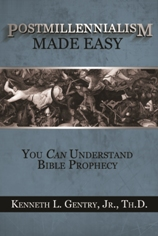









January 11, 2016
MISGUIDED REJECTIONS OF POSTMILLENNIALISM (3)
 PMT 2016-003 by Greg L. Bahnsen (edited by Kenneth L. Gentry, Jr.)
PMT 2016-003 by Greg L. Bahnsen (edited by Kenneth L. Gentry, Jr.)
(Ken Gentry note: This is the third in a four-part series on the sad practice of rejecting postmillennialism on faulty grounds. Dr. Bahnsen wrote this material and Kenneth L. Gentry, Jr., has edited it and offered here. This rejection falls on its own sword in that it involves two-edged criticisms. Let’s see how this is so.)
A third infelicitous way in which postmillennialism has been disposed of is by means of (allegedly) critical considerations which in fact apply as much to the other eschatological positions as to postmillennialism. This is particularly embarrassing as a scholarly lapse. But what do we mean?
One example, is that some have contended that there is incoherence among various postmillennialists rather than a unified theology, and in connection with this criticism it is observed that postmillennialism is adhered to by extremely divergent theological schools.[1] However, this is just as true of amillennialism and premillennialism; numerous details differ among proponents of these positions (indeed, one is inclined to think that they are more extensive and significant differences than those among proponents of these positions (indeed, one is inclined to think that they are more extensive and significant differences than those among postmillennialists), but this says nothing about the truth of their central tenets. Perhaps the clearest evidence of this problem is the strong antipathy that historic premillennialists (such as George Eldon Ladd, G. M. Beasley-Murray) have toward dispensational premillennialists. And the dispensationalists recognize this strong criticism of their position (as we see for instance in Ryrie’s, Dispensationalism).
Solid Ground (by Gabriel Fluhrer)
Insight and answers on: knowing God, the sufficiency of God’s Word, the truth of God, scripture alone, God’s word in the church, the accessibility of God’s Word, and the power of God’s Word.
See more study materials at: www.KennethGentry.com
Then again, postmillennialism is sometimes thought to be falsified through imputing guilt to it by association, observing that it has sometimes been held in some form by unitarians and liberals. But “premillennialism” has been advocated by the apostate Jews and modern cultists, and “amillennialism” is endorsed by neo-orthodox dialectical theology.
The fact that there are functional similarities between various evangelical and heretical theologians does not in itself settle the key question of which position is taught by God’s word; whichever millennial position is scriptural, it is nonetheless subject to misuse and inappropriation. Hence the use of one of these positions by an unorthodox writer does nothing in itself to discredit the position.
A further criticism which cannot be applied uniquely to postmillennialism is that it interprets biblical prophecy both figuratively [2] and literally.[3] The premillennialists see symbolic interpretation as a failure of nerve, and amillennialists take literal understanding of prophecy as crude and insensitive. But the fact remains that none of the three schools interprets biblical prophecy exclusively in either a literal or figurative fashion. (And, by the way, nobody really adheres to the rule, “Literal where possible,” as is evident from the respective treatments of the beast of Revelation, which could possibly be a literal monster but obviously is not.)
Getting the Message
(by Daniel Doriani)
Presents solid principles and clear examples of biblical interpretation.
See more study materials at: www.KennethGentry.com
All three eschatological schools end up finding both kinds of literature in the prophetic passages, and it is dishonest to give an opposite impression. If anything, the fact that postmillennialism is seen as too literal by amillennialists and too figurative by premillennialists perhaps suggests (certainly does not prove) that it alone has maintained a proper balance. The upshot is this: the charge of subjective spiritualization or hyperliteralism against any of the three eschatological positions cannot be settled in general; rather, the opponents must get down to hand-to-hand exegetical combat on particular passages and phrases.
Notes
1. John F. Walvoord, The Millennial Kingdom (Grand Rapids: Zondervan, 1959), 23, 34, 36.
2. Walvoord, The Millennial Kingdom, 24-25, 34.
3. William E. Cox, Amillennialism Today (Philadelphia: Presbyterian and Reformed, 1966), 20, 136; Jay E. Adams, The Time is at Hand (Nutley, N. J.: Presbyterian and Reformed, 1970), 15.
Click on the following images for more information on these studies:

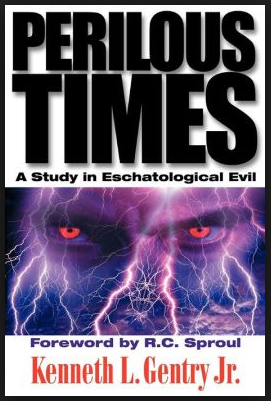
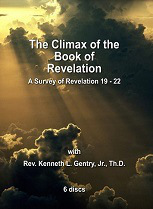









January 7, 2016
MISGUIDED REJECTIONS OF POSTMILLENNIALISM (2)
 PMT 2016-002 by Greg L. Bahnsen (edited by Kenneth L. Gentry, Jr.)
PMT 2016-002 by Greg L. Bahnsen (edited by Kenneth L. Gentry, Jr.)
This is the second in a four-part series on “Misguided Grounds for Rejecting Postmillennialism.” This article was originally written by Dr. Greg L. Bahnsen, but is presented here as edited by Kenneth L. Gentry, Jr. In this article, Dr. Bahnsen considers “Misrpresentation.”
Misrepresentation Documented
Postmillennialism has not only been discarded in this century on clearly unorthodox grounds; it has also been made a straw man so that modern advocates of the other schools of interpretation can easily knock it down and get on to other interests. The worst possible interpretation is put on postmillennial tenets, or the eccentric aspect of some postmillennial writer’s position is set forth as representing the basic school of thought.
As instances of these procedures we can note the following. Hal Lindsey says that postmillennialists believe in the inherent goodness of man,[1] and Walvoord says that the position could not resist the trend toward liberalism.[2] He also accuses it of not seeing the kingdom as consummated by the Second Advent.[3] William E. Cox claims that postmillennialism is characterized by a literal interpretation of Revelation 20.[4] Adams portrays the postmillennialist as unable to conceive of the millennium as coextensive with the church age or as a present reality,[5] for he (according to Adams) must see it as exclusively future – a golden age just around the corner.[6]
Pushing the Antithesis (by Ken Gentry)
Sub-title: The Apologetic Methodology of Greg L. Bahnsen
See more study materials at: www.KennethGentry.com
Finally, it is popularly thought and taught that postmillennialism maintains that there is an unbroken progression toward righteousness in history – that the world is perceptibly getting better and better all the time – until a utopian age is reached. Geerhardus Vos portrays the postmillennialist as looking for “ideal perfection” when “every individual” will be converted, and some will become “sinless individuals.”[7]
All of the above claims are simply inaccurate. The Calvinist, Loraine Boettner, certainly does not believe in man’s inherent goodness, and B. B. Warfield can hardly be accused of not resisting liberalism. That A. A. Hodge did not see the second coming of Christ as the great day of consummation is preposterous.
In addition, J. Marcellus Kik and many others insisted on a figurative interpretation of Revelation 20. Certain sixteenth- and seventeenth-century Dutch theologians, as well as Jonathan Edwards and E. W. Hengstenberg, were all postmillennialists who saw the millennium as coeval with the interadventual age (in which there would be progressive growth for the church in numbers and influence). Charles Hodge, Snowden, and Boettner were all postmillennialists who explained that the growth of Christ’s kingdom in the world suffers periodic crises, and Boettner has especially stressed the fact that it grows by imperceptible degrees over a long period.
Redeeming Pop Culture
by T. M. Moore
Why is it important for us not to ignore the culture around us? How can we engage, influence, and advance pop culture, and how can we put popular forms to good use in God’s kingdom? Moore urges us neither to flee from popular culture nor to immerse ourselves in it blindly.
See more study materials at: www.KennethGentry.com
Finally, anyone who thinks of postmillennialism as a utopian position misunderstands one or the other in their historically essential principles. Indeed, a chapter in Boettner’s book, The Millennium, is entitled, “The Millennium not a Perfect or Sinless State,” contrary to the misrepresentations of Vos. Nobody has ever propounded, in the name of evangelical postmillennialism, what Vos claimed (least of all his Princeton colleagues or predecessors). Therefore, the recent opponents of postmillennialism have not been fair to its genuine distinctives, but rather have misrepresented it as a general category of interpretation. This surely provides no firm ground for rejecting the position.
Misrepresentation Cures
All of this misrepresentation could easily be cured by three simple correctives:
First, the opponent of postmillennialism should read its leading, current-day representatives, not simply secondary sources bent on rejecting the eschatological system.
Second, the opponent should also read these representatives carefully. Some of the denunciations of postmillennialism cite the appropriate articles and books, but do so in an anti-contextual manner. All theological statements should be read in their contexts rather than jerked from them.
Third, he should have in mind an adequate definition of postmillennialism (such as Gentry gives in an earlier post: “Definining Postmillennialism”). How can you reject something of which you have no working definition? But such is the large-scale practice in evangelical debate today.
Notes
Hal Lindsey (with C. C. Carlson), The Late Great Planet Earth (Grand Rapids: Zondervan, 1970), 176.
John F. Walvoord, The Millennial Kingdom (Grand Rapids: Zondervan, 1959), 34.
Walvoord, The Millennial Kingdom, 31.
William E. Cox, Amillennialism Today (Philadelphia: Presbyterian and, 1966), 64.
Jay E. Adams, The Time is at Hand (Nutley, N. J.: Presbyterian and Reformed, 1970), 90.
Adams, The Time is at Hand, 2, 41.
Geerhardus Vos, “Outline of Notes on New Testament Biblical Theology,” 89, 90.
Click on the following images for more information on these studies:











January 4, 2016
MISGUIDED REJECTIONS OF POSTMILLENNIALISM (1)
 PMT 2016-001 by Greg L. Bahnsen (edited by Kenneth L. Gentry, Jr.)
PMT 2016-001 by Greg L. Bahnsen (edited by Kenneth L. Gentry, Jr.)
Introduction by Ken Gentry
Postmillennialism is perhaps the easiest eschatological system to misunderstand. And misunderstanding leads to rejection. This is the first in a four-part series on “Misguided Grounds for Rejecting Postmillennialism.” This article was originally written by Greg L. Bahnsen, but is presented here as edited by Kenneth L. Gentry, Jr. In this article, Bahnsen considers the problem of “Newspaper Exegesis.”
Newspaper Exegesis
It must be observed that postmillennialism lost favor (and today remains held in disfavor) with conservative theologians for manifestly unorthodox and insufficient reasons. Extra-biblical reasoning, as well as lazy or poor scholarship, has intruded itself into Christian discussions of eschatology. I will highlight four misguided grounds often used for rejecting this hope-filled eschatology. In this article I will focus on: Newspaper Exegesis.
Alva J. McClain says of postmillennialism: “This optimistic theory of human progress had much of its own way for the half-century ending in World War I of 1914. After that the foundations were badly shaken; prop after prop went down, until today the whole theory is under attack from every side. Devout Postmillennialism has virtually disappeared.”[1] J. Barton Payne’s massive Encyclopedia of Biblical Prophecy mentions postmillennialism only once, and that merely in a footnote which parenthetically declares “two world wars killed this optimism.”[2] Merrill F. Unger dismisses postmillennialism in short order, declaring: “This theory, largely disproved by the progress of history, is practically a dead issue.”[3] John F. Walvoord tells us that “In eschatology the trend away from postmillennialism became almost a rout with the advent of World War II” because it forced upon Christians “a realistic appraisal of the decline of the church in power and influence.”[4] Hence he says that “In the twentieth century the course of history,
progress in Biblical studies, and the changing attitude of philosophy arrested its progress and brought about its apparent discard by all schools of theology. Postmillennialism is not a current issue in millenarianism.”[5] He accuses it of failing to fit the facts of current history, of being unrealistic, and of being outmoded and out of step.[6]
Prodigal Press:
Confronting the Anti-Christian Bias of the American News Media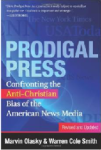
By Marvin Olasky and Warren Cole Smith
Issuing a clarion call for Christians to reclaim American journalism, Olasky and Smith examine the influence of worldviews on reporting, objectivity, sensationalism, and crusading; the impact of legal, ethical, and technological changes; and the changes brought about by the 24/7 news cycle, the Internet, and social media.
See more study materials at: www.KennethGentry.com
Jay Adams recognizes postmillennialism as a “dead issue” with conservative scholars, since it predicts a golden age while the world awaits momentary destruction; he agrees with the above authors that the “advent of two World Wars . . . virtually rang the death knell upon conservative postmillennialism.”[7] Adams apparently offers his own opinion that Boettner’s long-range postmillennialism “is too difficult to grant when Christians must face the fact of hydrogen bombs in the hands of depraved humanity.”[8] Hal Lindsey’s The Late Great Planet Earth captures well the attitude of these previous writers, stating that “there used to be” a group called “postmillennialists” who were greatly disheartened by World War I and virtually wiped out by World War II. Lindsey’s (poorly researched) conclusion is this: “No self-respecting scholar who looks at the world conditions and the accelerating decline of Christian influence today is a ‘postmillennialist.’”[9]
The sad fact is that our Christian brothers mentioned above should be embarrassed by what they have written and concluded; the attitude and reasoning they have set forth is woefully lacking as respectable Christian scholarship. By means of such newspaper exegesis, one could just as well discount the return of Christ in glory, saying “where is the promise of his coming?” (cf. II Peter 3:1-4). This reductio ad absurdum must be reckoned with. The fact that an era of gospel prosperity and world peace has not yet arrived would no more disprove the Bible’s teaching that such an era shall be realized (in the power of God’s spirit and the faithfulness of Christ’s church to its great commission) than the fact that Christ has not yet returned disproves the Bible’s teaching that such an event shall take place!
The only question is whether the Bible actually teaches these things. If it does, then “let God be true but every man a liar” (Rom. 3:4). The newspaper has no prerogative to challenge God’s word of truth. Nor do those who read the newspapers. As faithful disciples of Christ, we are to trust God as the sovereign controller over human history, “who works all things after the counsel of His own will” (Eph. 1:11), “declaring the end from the beginning and from ancient times things not yet done, saying, ‘My counsel shall stand, and I will accomplish all my purpose’” (Isa. 46:10), so that “none can stay his hand” (Dan. 4:35). With the Psalmist we should declare, “Whatever the Lord pleases, he does, in heaven and on earth” (115:3). If God says something is to happen, then it shall happen; it is to our discredit if we are men of little faith with respect to his promises.
Standard Bearer: Festschrift for Greg Bahnsen (ed. by Steve Schlissel)
Includes two chapters by Gentry on Revelation and theonomy.
See more study materials at: www.KennethGentry.com
Just imagine the following scenario: devout Simeon is in the temple looking for the consolation of Israel (cf. Luke 2), when a popular Jewish theologian comes in and tells him, “Simeon, your hope of a personal Messiah is a dead issue, an idealistic anachronism. Your unrealistic theory has been disproved by the course of history and discarded by all schools; it is out of date, outmoded, and no longer a current issue. No self-respecting scholar who looks at the world conditions and remembers the four hundred years of silence from God believes as you do; prop after prop has gone down, and the events that have come upon our nation have killed the optimism of your theory.” Would any conservative theologian say that Simeon’s belief had been refuted or incapacitated by such considerations? Would any think him justified in no longer treating it as a vital position worthy of scriptural consideration? Of course not. Likewise biblical postmillennialism cannot be thus dismissed.
Notes
“Premillennialism as a Philosophy of History,” in W. Culbertson and H. B. Centz, eds., Understanding the Times (Grand Rapids: Zondervan, 1956), 22.
J. Barton Payne, Encyclopedia of Biblical Prophecy (New York: Harper and Row, 1973), 596.
“Millennium,” Unger’s Bible Dictionary (Chicago: Moody, rev. 1961), 739.
John F. Walvoord, The Millennial Kingdom (Grand Rapids: Zondervan, 1959), 9.
Walvoord, The Millennial Kingdom, 18.
Walvoord, The Millennial Kingdom, 35, 36.
Jay E. Adams, The Time is at Hand (Nutley, N. J.: Presbyterian and Reformed, 1970), 2.
Adams, The Time is at Hand, p. 4.
Hal Lindsey (with C. C. Carlson), The Late Great Planet Earth (Grand Rapids: Zondervan, 1970), 176.
Click on the following images for more information on these studies:


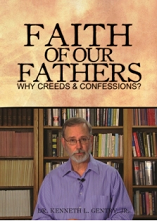








December 31, 2015
IS REVELATION PAST? (4)
 PMT 2015-155 by Kenneth L. Gentry, Jr.
PMT 2015-155 by Kenneth L. Gentry, Jr.
I am now drawing to the conclusion of my four-part series on the reasoning behind a preteristic understanding of Revelation. Many deem the great judgments and upheaval of Revelation as undermining the glorious postmillennial hope. This is mistaken in that the bulk of Revelation was fulfilled in the first century. As we have been seeing.
I am now ready for my concluding article with the: Thematic Indicators
As mentioned in previous articles, the theme of divine judgment on Israel fits perfectly with the Olivet Discourse. Virtually all commentators note the remarkable parallels between Matthew 24 and Revelation 6. These parallels are sufficient alone to suggest the same theme, but other correspondences exist.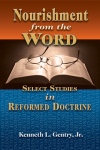
Nourishment from the Word
(by Ken Gentry)
Reformed studies covering baptism, creation, creeds, tongues, God’s law, apologetics, and Revelation
See more study materials at: www.KennethGentry.com
In Matthew 23 Christ scathingly denounces Israel’s leadership as he approaches the dramatic conclusion of his earthly ministry. He notes that Israel’s present failure is not an isolated event, but the culmination of a lengthy historical pattern — as do Stephen (Ac 7) and Paul (1Th 2:14-16). He concludes his rebuke with a prophecy that Israel will “fill up” (Mt 23:32) her guilt in “this generation” (23:36) when she “persecutes” those Jesus is “sending” (23:34; cp. Ac 8:1; 1Th 2:14-16).
Thereupon, Jesus weeps over Jerusalem (23:37), declares her temple “desolate” (23:38), and ceremoniously departs from it (24:1a). When the disciples express confusion at his rejection of the temple (24:1b), He prophesies its utter destruction (24:2). This specific prophecy prompts the disciples’s questions about the time of this judgment (24:3). Jesus responds with his Olivet Discourse. The first portion of the discourse (24:2-34) focuses particularly on the temple (Mt 24:2) in Judea (v. 16) during that “this generation” (v. 34),1 just as John’s Revelation focuses on the Jews (1:7; 2:9; 3:9) and the temple (11:1-8) in the near future (1:1, 3; 22:6, 10). As noted above, both John and Jesus merge Zechariah 12:10 and Daniel 7:13 in this context of approaching judgment upon Israel (Mt 24:30; Rev 1:7). Both prophecies warn of A.D. 70.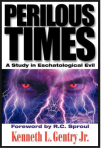
Perilous Times: A Study in Eschatological Evil (by Ken Gentry)
Technical studies on Daniel’s Seventy Weeks, the great tribulation, Paul’s Man of Sin, and John’s Revelation.
See more study materials at: www.KennethGentry.com
Furthermore, several other NT passages warn of the Jerusalem’s judgment in A.D. 70:
“Truly I say to you, there are some of those who are standing here who shall not taste death until they see the kingdom of God after it has come with power” (Mk 9:1).
“The Jews, who both killed the Lord Jesus and the prophets, and drove us out. They are not pleasing to God, but hostile to all men, hindering us from speaking to the Gentiles that they might be saved; with the result that they always fill up the measure of their sins. But wrath has come upon them to the utmost” (1Th 2:15-16).
“Not forsaking our own assembling together, as is the habit of some, but encouraging one another; and all the more, as you see the day drawing near” (Heb 10:25).
“You too be patient; strengthen your hearts, for the coming of the Lord is at hand” (Jas 5:8-9).
“The end of all things is at hand; therefore, be of sound judgment and sober spirit for the purpose of prayer” (1Pe 4:7).
This all fits well with an AD 70 focus. This all supports the preterist analysis of Revelation.
Click on the following images for more information on these studies:












December 28, 2015
IS REVELATION PAST? (3)
 PMT 2015-154 by Kenneth L. Gentry, Jr.
PMT 2015-154 by Kenneth L. Gentry, Jr.
This is my third installment on the question of the evidence that Revelation was fulfilled in the first century. As surprising as this conclusion is for the modern evangelical, the proof is in Revelation itself. In this article I will consider the Historical Indicators for preterism.
I agree with the Puritan Talmudic scholar, John Lightfoot: Revelation appears to prophesy Christ’s judgment upon the Jews in A.D. 70. John’s opening statement of purpose (1:7), the seven letters (2:9; 3:9), and the body of Revelation (4-19; e.g., 7:1-8; 11:1-8) all reflect this truth.
Just after mentioning the nearness of the events (1:1, 3) and just before alluding to the dire circumstances of his original audience (1:9), verse 7 warns: “Behold he comes with the clouds, and will see him every eye and those who him pierced, and will wail over him all the tribes of the land. Yes, amen” (Alfred Marshall, The Interlinear Greek-English NT; cp. Robert Young, Literal Translation). Though this sounds like a Second Advent reference, the following evidence points to A.D. 70.
Coming with the Clouds
Cloud-coming language often speaks of historical divine judgments. For instance, Isaiah 19:1a warns: “An oracle concerning Egypt: See, the LORD rides on a swift cloud and is coming to Egypt” (cp. Ps 18:7-15; 104:3; Joel 2:1,2; Na 1:2ff.; Zep 1:14,15). This speaks of the Assyrian king Esarhaddon conquering Egypt in 671 B.C. As Young notes: “The scene does not necessarily suggest that the Lord comes from the Temple at Jerusalem nor from heaven, but merely that He comes as a judge” (Isaiah, 2:14), i.e., providentially, not personally.
Interestingly, John follows Jesus in merging Zechariah 12:10 and Daniel 7:13. Like John, Jesus mentions the “coming on the clouds” (cp. Mt 24:29-30) against Israel (Mt 23:36-24:2, 16). And like John, Jesus ties the events to the near future: “all these things shall come upon this generation” (Mt 24:34).
Great Tribulation: Past or Future?
(Thomas Ice v. Ken Gentry)
Debate book on the nature and timing of the great tribulation. Both sides thoroughly cover the evidence they deem necessary, then interact with each other.
See more study materials at: www.KennethGentry.com
Those Who Crucified Christ
Christ’s judgment-coming is against: “they who pierced him.” Jesus blames the Jews for his death: “Christ began to show His disciples that He must go to Jerusalem, and suffer many things from the elders and chief priests and scribes, and be killed” (Mt 16:21; cp. Mt 20:18-19; 21:33-43; Mk 8:31; Lk 9:22). The apostles also lay the covenantal blame for his crucifixion upon Israel: “Then know this, you and all the people of Israel: It is by the name of Jesus Christ of Nazareth, whom you crucified” (Ac 4:10a; cp. Jn 19:5-15; Ac 2:22, 23, 36; 3:14, 15; 4:8-10; 5:30; 10:39; 1Th 2:14-16). Revelation 1:7 must refer to the first century in that those who “pierced him” are now long since deceased.
The Tribes of the Land
This judgment brings mourning upon “all the tribes of the land” (1:7; Marshall’s Interlinear). These “tribes” (phyle) must be the tribes of Israel (cf. Mt 19:28; Lk 22:30). TDNT notes that the Septuagint “with few exceptions . . . has phyle, so that this becomes a fixed term for the tribal system of Israel” (9:246). Revelation clearly mentions those Jews who were saved out from “the tribes” of Israel (7:4-8; cp. 21:12); and John sets these over against other “tribes and peoples” beyond Israel (7:9; cp. 11:9).
What is more, John associates these “tribes” with “the land” (tes ges), the well-known Promised Land (cp. Lk 21:23). As Edersheim observes: “Palestine was to the Rabbis simply ‘the land,’ all other countries being summed up under the designation of outside the land.”1 Indeed, the OT mentions “the tribes” and “the land” together in numerous instances (e.g., Ge 49:16; Nu 26:55; Jos 14:1; 19:51; Eze 45:8; 48:29).
Kids Who Kill
(by Gov. Mike Huckabee)
Proposes a key to recovering our country’s basic values: faith, family, work, and community.
See more study materials at: www.KennethGentry.com
In the seven letters John specifically mentions the defection of the Jews from God. He even informs the churches that Christ will vindicate them by judging the Jews:
• “I know your tribulation and your poverty (but you are rich), and the blasphemy by those who say they are Jews and are not, but are a synagogue of Satan.(2:9)
• Behold, I will cause those of the synagogue of Satan, who say that they are Jews, and are not, but lie, behold, I will make them to come and bow down at your feet, and to know that I have loved you.” (3:9)2
Surely this humiliation of the Jews was in the lifetime of the recipients of Revelation — in A.D. 70 when the Jews were “cast out” (Mt 8:10-12) and the kingdom was given to the gentiles (Mt 21:40-43).
The Temple and Holy City
Revelation expressly mentions the coming destruction of the temple, and with language drawn from the Olivet Discourse.
“Jerusalem will be trampled on by the Gentiles until the times of the Gentiles are fulfilled” (Lk 21:24b).
“But exclude the outer court; do not measure it, because it has been given to the Gentiles. They will trample on the holy city for 42 months” (Rev 11:2).
Note that both of these passages inform us that the “holy city/Jerusalem” will be “trampled” by the “gentiles.” And both appear in prophecies confined to the short term (1:1, 3; 22:6, 10; Lk 21:31-32). Evidently, these texts are referring to the same events, with John deriving his cue from Christ’s discourse about A.D. 70 (Lk 21:6-7).
Interestingly, the time of the formal imperial engagement of the Jewish War until the destruction of the temple was forty-two months. According to Bruce, after the initial Jewish uprising in A.D. 66, Vespasian “arrived the following spring [A.D. 67] to take charge of operations. . . . Titus began the siege of Jerusalem in April, 70. The defenders held out desperately for five months, but by the end of August, the Temple area was occupied and the holy house burned down, and by the end of September all resistance in the city had come to an end.”3 From Spring A.D. 67 to September A.D. 70, covers a period right at forty-two months. This is a remarkable correspondence which fits relevantly with all the other data.
And now: three down, one more to go! My next article will conclude this series.








December 24, 2015
THE BIRTH OF THE KING
 PMT 2014-154 by Kenneth L. Gentry, Jr.
PMT 2014-154 by Kenneth L. Gentry, Jr.
If you reading this at its original posting: Merry Christmas! If not, I hope you haven’t missed Christmas.
The original Christmas was a time fully anticipating the postmillennial hope in history. Not only are many of our Christmas hymns very postmillennial, but they are so because the biblical narrative presenting Christ’s birth is!
In paradigmatic, biblico-theological fashion, in the first chapter of his gospel Luke draws upon and arranges the old covenant expectations that arise in response to the announcement of Christ’s birth. As he brings the Old Testament expectations over into the New Testament, he rephrases the prophecies in terms of their New Covenant fruition. Interestingly, most of these are in poetic-song format, indicating the joyousness of the expectations (Lk 1:46–55, 67–79; 2:14, 29–32).
The Angelic Annunciation
In the angelic annunciation to Mary, we hear of God giving Christ David’s throne and promising that he will rule endlessly: “‘He will be great, and will be called the Son of the Highest; and the Lord God will give Him the throne of His father David. And He will reign over the house of Jacob forever, and of His kingdom there will be no end’” (Lk 1:32–33). This is surely an “echo of the sublime prediction” in Isaiah 9:6–7 [David Brown, “Matthew,” Jamieson, Faussett, Brown Commentary, 2:97].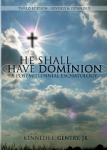
He Shall Have Dominion
(paperback by Kenneth Gentry)
A classic, thorough explanation and defense of postmillennialism (600+ pages). Complete with several chapters answering specific objections.
See more study materials at: www.KennethGentry.com
We should remember that Isaiah 9:6–7 ties in kingdom dominion with the birth of the king as historically successive realities. We also see that Daniel 7:13 equates Christ’s coronation with his historical ascension. Daniel 2 also speaks of his kingdom coming in the days of the fourth kingdom, Rome (Da 2:40–45). The New Testament pattern is: humiliation followed immediately by exaltation (Jn 7:39; Lk 24:26; 1Pe 1:11). Furthermore, the New Testament shows that he presently rules as Messianic king and that his rule never ends. Christ receives “David’s throne” as per Old Testament prophecies (Ac 2:29–36; 3:13–15; 5:29–31; Rev 3:7).
The reference in Luke 1:33 to Christ’s ruling over “the house of Jacob” is significant. Jacob is the father of the “twelve tribes of Israel” (Ge 35:22–27). Thus, this we should understand this as alluding to the totality of the “Israel of God,” which includes all of the redeemed, Jew and Gentile alike. Luke’s companion, Paul, makes this especially clear (Gal 3:29; 6:16; Eph 2:12–22).
Mary’s Magnificat
Mary’s praise to God in Luke 1:46–55 reverberates with the victory theme. In verses 47 and 48, she exalts the Lord as Savior, recognizing God’s glorious blessing upon her: “From this time on all generations will count me blessed.” Why this universal homage? Because “the Mighty One” (v 49) is now moving in history in a powerful way and using Mary for his glory. This declaration receives its impulse from the prophetic victory theme; it counters any notion of despair, any tendency to lamentation, any expectation of perpetual suffering.
Postmillennialism Made Easy 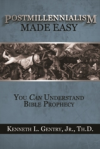
(by Ken Gentry)
Basic introduction to postmillennialism. Presents the essence of the postmillennial argument and answers the leading objections. And all in a succinct, introductory fashion.
See more study materials at: www.KennethGentry.com
Mary recognizes that in the soon-coming birth of Christ, God will do “mighty deeds with His arm” for he will “scatter the proud” (Lk 1:51). He will “bring down rulers” and “exalt those who are humble” (v 52). He will fill “the hungry with good things” (v 53). He will do it through his people (v 54) in keeping with the Abrahamic Covenant (v 55). This glad song reverberates with hope and contains absolutely no intimation of defeat.
Zacharias’ Prophecy
Zacharias continues the hope-filled joy, for he sees Christ’s birth as bringing glad tidings of victory for God’s people over their enemies (Lk 1:68–71). This again fulfills the Abrahamic Covenant (v 73; cf. Ro 15:8–12). Christ is the sunrise that will “shine upon those who sit in darkness and the shadow of death” (vv 78–79). Elsewhere this refers to the Gentiles (Isa 9:1, 2; Mt 4:16).
Later in the New Testament we see this light as a positive force, dispelling darkness in the present age (Ro 13:11–13; 1Jn 2:8). Because Christ has come, he will bring “peace on earth” (Lk 2:14a). His birth at his first coming insures peace on earth — not his second coming (although in the consummative new earth this peace will come to perfect, eternal realization).








December 21, 2015
IS REVELATION PAST? (2)
 PMT 2015-152 by Kenneth L. Gentry, Jr.
PMT 2015-152 by Kenneth L. Gentry, Jr.
In my last article I introduced the first of four arguments for approaching Revelation from the preterist perspective. The first article focused on the temporal indicators that John places in Revelation. Lexically, it is clear that he expected the events to “soon” take place (Rev 1:1) because “the time is near” (Rev 1:3).
But after placing that argument as the foundation stone for the preterist house, we need to notice that there are other indications as well. In this installment I will consider Audience Indicators. Revelation did not fall down out of heaven as book of concepts. It was given in a real, historical context. It is what scholars call, “occasional literature.” That is, it was written regarding a certain occasion, which I believe to be the fall of Jerusalem and the temple in AD 70.
John emphasizes the nearness of his prophetic events, in a way most relevant to his original recipients. In fact, to delay the prophetic events thousands of years would contradict his whole point in writing Revelation.
Navigating the Book of Revelation 
(by Ken Gentry)
Technical studies on key issues in Revelation, including the seven-sealed scroll, the cast out temple, Jewish persecution of Christianity, the Babylonian Harlot, and more.
See more study materials at: www.KennethGentry.com
First, John writes to seven historical churches. Immediately after twice declaring the nearness of the events (1:1, 3) we read: “John to the seven churches that are in Asia” (1:4a). In 1:11 and 2:1–3:22 he specifically names the churches. John informs these first century churches of events ‘soon’ (1:1) to come to pass because “the time is near” (1:3). How could they have understood John to really mean that either 2,000 years would elapse before the events broke out or that they would drag on and repeat themselves for 2000 years?
Second, studies by William Ramsey and Colin Hermer show how intimately Revelation addresses those specific churches regarding their histories, settings, and struggles. The seven letters are occasional letters designed specifically for their concerns.
Third, within these letters we also find temporal qualifiers suggesting those churches would experience the shock waves from the events of Revelation (2:5; 2:16; 3:11; 22:12, 20). One of them was “about to” be tried by Satan (2:10; cp. 1:19 Gk.). To another Christ is “coming quickly” in judgment (2:16; cp. 1:1). To still another He promises: “I also will keep you from the hour of testing, that hour which is about to come upon the whole world [oikumene]” (3:10; cp. 1:19 Gk.). Indeed, a church must “hold fast” for awhile in that Christ’s judgment-coming will trans transpire “quickly” (3:11; cp. 1:1).
Survey of the Book of Revelation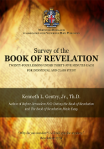
(DVDs by Ken Gentry)
Twenty-four careful, down-to-earth lectures provide a basic introduction to and survey of the entire Book of Revelation. Professionally produced lectures of 30-35 minutes length.
See more study materials at: www.KennethGentry.com
Fourth, John wrote Revelation while these churches were enduring stressful times: “I, John, your brother and fellow partaker in the tribulation and kingdom and perseverance which are in Jesus” (1:9a). Revelation promises quickly to vindicate the martyrs who cry: “How long?” (6:9). The were told “they should rest for a little while longer” (6:10-11; cp. Lk 18:7-8). In fact, later in Revelation, we learn “there shall be delay no longer” (10:6). Yet, on the non-preterist interpretation, their vindication was not after “a little while,” and the events await an enormous delay.
And there is more! But you will have to wait for the next article in this series (after Christmas!).








December 17, 2015
IS REVELATION PAST? (1)
 PMT 2015-151 by Kenneth L. Gentry, Jr.
PMT 2015-151 by Kenneth L. Gentry, Jr.
Due to the widespread influence of dispensationalism, the preterist approach to Revelation shocks many Christians. So it is important to carefully introduce them to the exegetical rationale for this approach.
I believe we should present a four-fold exegetical justification for preterism in Revelation. These justifications are rooted in interpretive demands derived from the text itself, not from theological predispositions (e.g., anti-premillennialism) or from traditional predilections (e.g., Moses Stuart, Milton Terry).
So I will begin with in this first article with: Temporal Indicators.
The leading preterist evidence derives from John’s temporal delimitations, which he emphasizes by strategic placement, didactic assertion, frequent repetition, and careful variation.
Blessed Is He Who Reads: A Primer on the Book of Revelation
By Larry E. Ball
A basic survey of Revelation from the preterist perspective. It sees John as focusing on the destruction of Jerusalem and the temple in AD 70.
See more study materials at: www.KennethGentry.com
He strategically places them twice in his introduction (1:1, 3) and five times in his conclusion (22:6, 7, 10, 12, 20), thereby bracketing the highly wrought drama within (4:1–22:6). In these didactic passages John employs two terms demanding preterism: tachos / tachu (1:1, cp. 22:7, 12, 20) and eggus (1:3; cp. 22:10). For example:
The Revelation of Jesus Christ, which God gave Him to show to His bond-servants, the things which must shortly [tachos] take place. . . . Blessed is he who reads and those who hear the words of the prophecy, and heed the things which are written in it; for the time is near [eggus]. (1:1a, 3)
John immediately impresses upon his reader the nearness of his prophetic events.
Lexicographers agree on the temporal significance of tachos in Revelation: The Baur-Arndt-Gingrich-Danker Lexicon (BAGD) notes that en tachei means: “soon, in a short time Lk 18:8; Ro 16:20; 1 Ti 3:14 v.1; Rv 1:1; 22:6; 1 Cl 65:1; shortly Ac 25:4.” Thayer offers the following range of meanings: “quickness, speed and quickly, shortly, speedily, soon,” listing Revelation 1:1 and 22:6 with the “speedily, soon” entries. Abbott-Smith concurs: 1:1 and 22:6 mean “quickly, speedily, soon.”
Greek text editors F. J. A. Hort, Kurt Aland, and Howard Marshall agree. Hort translates it “shortly, soon.” Aland comments: “In the original text, the Greek work used is tachu, and this does not mean ‘soon,’ in the sense of ‘sometime,’ but rather ‘now,’ immediately.” Marshall cites Revelation 1:1 and 22:6 as evidence that the normal use of the phrase en tachei “suggest[s] that soon is the meaning.”
In fact, all English versions translate it either as: “soon” (NIV, RSV, Beck, NRSV, NAB, CEV), “shortly” (KJV, ASV, Weymouth, NEB, NASB, NKJV), or “very soon” (Moffatt, Phillips, Williams, TEV). Tachos obviously indicates temporal brevity elsewhere (e.g., Lk 18:8; Ac 12:7; Ro 16:20). The same is true of its related form tachus (Mt 5:25; Mk 9:39; Lk 15:22; cp. Rev 2:16; 3:11; 11:14; 22:7, 12, 20).
Book of Revelation Made Easy
(by Ken Gentry)
Helpful introduction to Revelation presenting keys for interpreting. Also provides studies of basic issues in Revelation’s story-line.|
See more study materials at: www.KennethGentry.com
This evidence is reinforced by John’s linking tachos with eggus in the same contexts, as if to provide a two-fold witness (1:1, 3; 22:6, 10). BAGD provides the following entry for eggus: “of time near a. of the future: kairos Mt 26:18; Rv 1:3; 22:10.” The other lexicons cited above concur. TDNT notes that the term means “temporally near at hand” and observes that “like the Synpt., Rev. uses eggus only as a term for the near coming of the kingdom of God. Thus we have ho gar kairos eggus in 1:3; cf. 22:10″ (3:330, 331). The various samples of eggus in the NT all agree: some relating spatial, others temporal nearness (Mt 24:32, 33; 26:18; 13:28, 29; Lk 19:11; 21:30, 31). And again, all translations of Revelation agree; all versions cited above have either “near” or “at hand.”
Perhaps the most interesting proof of the meaning of these terms is the various competing, innovative, counter-intuitive attempts to get around their obvious significance! Indeed, if these terms do not express temporal nearness, what terms could John have used to do so? I am firmly convinced John prophesies the fast approaching destruction of the Temple in A.D. 70.
But there is more. I will engage the second line of evidence in my next article.
Click on the following images for more information on these studies:


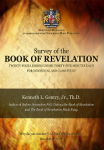








December 14, 2015
SATAN’S BINDING; YOUR HOPE (2)
 PMT 2015-150 by Kenneth L. Gentry, Jr.
PMT 2015-150 by Kenneth L. Gentry, Jr.
In my previous article I began a two-part study on the binding of Satan as an important feature of the postmillennial hope. This article concludes the thoughts begun there.
The dramatic imagery that John employs in Revelation 20:1–3 teaches that Satan has been “bound” so that he “should not deceive the nations any longer.” This allows all those who are spiritually resurrected believers to “reign with him” in his kingdom. Despite popular misunderstanding of this passage, this vision speaks of realities already established in Christ’s first coming, as we can tell from several reasons.
Scripture’s Reasons
First, Christ informs us that He has already bound Satan: “If I cast out demons by the Spirit of God, then the kingdom of God has come upon you. Or how can anyone enter the strong man’s house and carry off his property, unless he first binds the strong man? And then he will plunder his house” (Matt. 12:28-29). Whatever else we might think, Christ Himself declares He has bound this strong one during his earthly ministry so that He may spoil Satan’s kingdom while establishing His own. Here Satan’s binding and Christ’s kingdom are linked together by the Lord who was teaching John who later penned Revelation 20.
21 mp3 Reformed messages on Christmas by Ken Gentry
Includes studies of images of Christ in manger scenes, consideration of the legitimacy of celebrating Christmas, Christmas miracles (incarnation, conception, and revelation), Christmas and the new creation, and more. Excellent for personal study or pastoral ideas.
See more study materials at: www.KennethGentry.com
Second, Christ also teaches that salvation by grace through faith effects a spiritual resurrection to new life: “Truly, truly, I say to you, he who hears My word, and believes Him who sent Me, has eternal life, and does not come into judgment, but has passed out of death into life. Truly, truly, I say to you, an hour is coming and now is, when the dead shall hear the voice of the Son of God; and those who hear shall live” (John 5:24-25; cp. Eph. 2:5-6; Rom. 6:5-11; 1 John 3:14). This is the backdrop to the image of the “first resurrection” in Revelation 20. Christ teaches two resurrections, which John the author of Revelation records for us: the first resurrection is a spiritual one while we are in our present life (John 5:25), the second a physical one after we leave this world at the end of history (John 5:28-29; cp. John 6: 39, 44, 54; 11:24).
Third, in the didactic introduction to Revelation John declares that we are already a kingdom of priests, which he presents in dramatic imagery in Revelation 20: “He has made us to be a kingdom, priests to His God and Father; to Him be the glory and the dominion forever and ever” (Rev. 1:6). Note the past tense: “He has made us to be a kingdom, priests.” This historical reality, which already exists when he writes Revelation, explains the symbolic vision of chapter 20 which declares: “they will be priests of God and of Christ and will reign with Him” (Rev. 20:6).
Fourth, we must note that Satan’s binding does not totally incapacitate him. Rather his binding is for an expressly declared purpose: “that he should not deceive the nations any longer” (Rev. 20:3). This speaks of the “plundering of his house” (Matt. 12:29): Satan is bound by the first century coming of Christ’s kingdom so that he may not continue to deceive and dominate the nations any longer. In the Old Testament era only Israel knew God: “He declares His words to Jacob, His statutes and His ordinances to Israel. He has not dealt thus with any nation; And as for His ordinances, they have not known them. Praise the Lord!” (Psa. 147:19-20). “You only have I chosen among all the families of the earth” (Amos 3:2a; cp. Deut. 7:6-7). This is why Christ did not dispute Satan’s claim when he showed Him “all the kingdoms of the world” and said: “I will give You all this domain and its glory; for it has been handed over to me’” (Luke 4:5-6).
It is only in the past that “in the generations gone by He [God] permitted all the nations to go their own ways” (Acts 14:16). But now the whole world is open to release from Satan’s absolute dominion because of his having been bound by Christ. The Great Commission, therefore, confidently sends us out to “make disciples of all the nations” (Matt. 28:19)1 who previously were totally subject to Satan and “without hope” (Eph. 2:12). Jesus declares to Paul that he is sending him to open the Gentiles’ eyes “so that they may turn from darkness to light and from the dominion of Satan to God, in order that they may receive forgiveness of sins and an inheritance among those who have been sanctified by faith in Me” (Acts 26:18).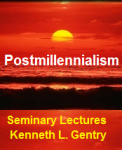
(DVDs by Ken Gentry)
Formal, full seminary course developing and defending postmillennial eschatology.
See more study materials at: www.KennethGentry.com
Christ’s victory over Satan is spoken of frequently, and under various images in addition to “binding”:
“He said to them, ‘I was watching Satan fall from heaven like lightning’” (Luke 10:18).
“Now judgment is upon this world; now the ruler of this world shall be cast out” (John 12:31).
“Concerning judgment, because the ruler of this world has been judged” (John 16:11).
“Since then the children share in flesh and blood, He Himself likewise also partook of the same, that through death He might render powerless him who had the power of death, that is, the devil” (Heb. 2:14).
“And the God of peace will soon crush Satan under your feet” (Rom. 16:20a).
“He had disarmed the rulers and authorities, He made a public display of them, having triumphed over them through Him” (Col. 2:14).
“The Son of God appeared for this purpose, that He might destroy the works of the devil” (1 John 3:8b).
Our Hope
Christian, because of Christ’s triumph over Satan, the Scriptures promise you victory. As redeemed vessels of mercy, you must neither despair in your struggles nor blame Satan for your failures. Too many Christians pick up on deficient theology rampant in trite maxims such as “I can resist anything but temptation” and “the devil made me do it.”
You must remember that Christ has prayed for you: “I do not ask Thee to take them out of the world, but to keep them from the evil one” (John 17:15). He has taught you yourself to pray: “do not lead us into temptation, but deliver us from the evil one” (Matt. 6:13).
The Bible teaches how that you may “put on the full armor of God, that you may be able to stand firm against the schemes of the devil” (Eph. 6:11). You are directed to “not give the devil an opportunity” (Eph. 4:27). You can “submit therefore to God” so that if you “resist the devil . . . he will flee from you” (James 4:7).
Satan is a powerful foe, but he is a defeated foe. Otherwise such biblical directives regarding victory over Satan would be meaningless. Christ has bound him so that he may not dominate us. The victory is ours if we but seize it.









Kenneth L. Gentry Jr.'s Blog
- Kenneth L. Gentry Jr.'s profile
- 85 followers


